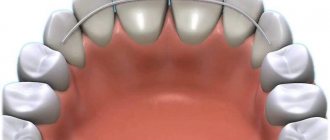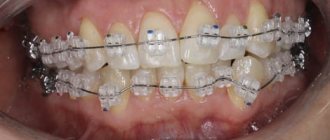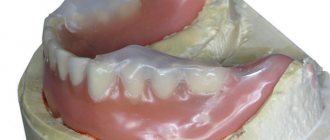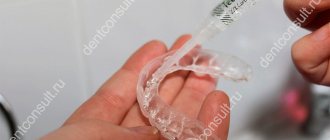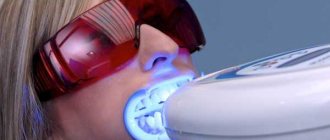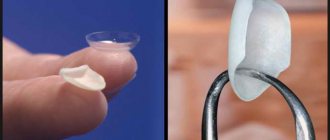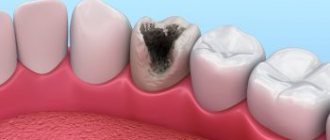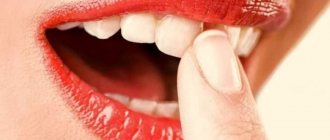Some dental diseases make it impossible to save the tooth, and it has to be removed. The older a person is, the more such teeth are found. And there comes a time when the question of inserts arises. Progress in dentistry is now such that there are already more than a dozen varieties of removable prosthetic structures, and even more permanent dentures. But, nevertheless, even taking into account such diversity, classic models, such as overhead structures, continue to be in demand.
Composite onlays for teeth
Therapeutic, or composite, onlays for teeth are used in cases where the goal is to build up a badly damaged tooth, and not just improve aesthetics. For example, they can be used in case of severe chipping of the incisor (more than half the area) or in other cases when orthopedic veneers are simply useless due to the impossibility of their installation. Such dental overlays are made using the direct method, that is, immediately on the patient’s tooth, from composite materials, hence their name – composite veneers. Therapeutic overlays have a standard color range, so in some cases the patient cannot choose the appropriate shade. The advantage of this type of onlay is that the patient receives a visible result in one visit; in addition, the price of onlays for teeth made of a composite is significantly lower than classic ceramic veneers.
Contraindications
However, in some cases it is not practical to install nylon plates. For example, if the bone tissue of the jaw has undergone severe deformation, there is a history of stage 3-4 periodontal disease, or the supporting teeth have a crown that is too low. In such cases, it is advisable to consult a doctor regarding a possible alternative.
Overlays for crooked teeth
In some cases, dental onlays can be used to correct minor defects in the dentition. These include veneers, as their thickness allows you to hide imperfections. Overlays on teeth that are too thin, such as lumineers and ultraneers, will not cope with this task. You can use onlays for leveling only if the patient has a correct bite - installing such onlays on the teeth to solve the problem of correcting the bite will not bring any effect. They are helping:
- camouflage crooked teeth;
- correct too short teeth;
- get rid of a gummy smile (the problem is solved in combination with gum surgery);
- give a lifting effect to the cheekbones (when installing onlays on chewing teeth).
If significant adjustments are required, it is better to opt for ceramic onlays for teeth, as they are reliable and aesthetically pleasing. Composite veneers can be used to correct minor defects. The price of such dental overlays is significantly lower than the cost of ceramic veneers.
In addition to veneers, if teeth are slightly crowded, crowns can also be used - they help correct the curvature of one or more teeth. The disadvantage of this method of installing onlays on crooked teeth is the need to prepare healthy dental tissues, which not every patient will do. This method is considered quite aggressive. The advantages include quick results, in contrast to using a braces system.
Teeth onlays to correct bite
If the patient has no complaints about the enamel and is only interested in correcting crowded teeth, the doctor may suggest treatment with special mouthguards or aligners. Unlike fixed orthodontic structures, they can be removed during meals and during oral hygiene procedures. They are practically invisible on the teeth, as they are made of transparent material. Due to their tight fit to the dentition, removable onlays promote gradual teeth alignment. The disadvantage of treatment with mouthguards is their limited effect. If you have a complex case, then it is better to opt for aligners, which are as effective as braces.
Veneers
Veneers are ceramic plates used to restore the front row of teeth. They are installed on both the upper and lower teeth.
Veneers can eliminate many defects:
- crooked teeth;
- enlarged interdental gaps;
- chips and cracks;
- pigmentation or darkening of the enamel.
To fix veneers, it is necessary to grind a thin layer of enamel and secure them with special cement, which will securely hold the structure on the teeth. The service life of veneers is up to 15 years
. They do not require special care.
Aesthetic onlays for teeth
By “Hollywood” we mean a snow-white, even smile, which is associated with the smiles of movie stars - the generally accepted standard is four front teeth that are level with each other. In this case, the teeth must be large enough. In Russia, this concept simply means straight and white teeth. A similar result can be achieved in various ways. If, due to aesthetic defects, increased sensitivity or slight curvature of teeth, it is not possible to limit yourself to minimally invasive procedures, then cosmetic dental veneers are used. In aesthetic dentistry the following are used: veneers, ultraneers, compositers and lumineers. All of these types of aesthetic dental onlays are made in a dental laboratory using individual impressions of the patient’s teeth and then attached to the enamel surface.
In order to improve the aesthetics of the dentition, including hiding minor defects in the surface of the teeth, ceramic dental veneers are most often used, since this material is closest to the natural tooth enamel. The peculiarity of installing such onlays on teeth is that the procedure requires preliminary grinding of the enamel to the thickness of the veneer (0.3 - 0.7 mm). In addition, vinyl overlays for teeth are often used today; they are somewhat inferior to ceramic veneers in terms of characteristics, but are more affordable in cost. The number of plates installed may vary depending on the width of the smile. In cases where the teeth are severely damaged (less than 10% of the tissue remains) or there is a slight curvature of the dentition, crowns are used to achieve a Hollywood smile.
To achieve maximum strength, veneers are made of zirconium dioxide or aluminum (only the frame is made of metal, and the upper crown is made of ceramic), but in this case, the onlays on the teeth do not transmit light as well, so upon close examination the difference may be noticeable. In this regard, it is worth making an informed decision: either ceramic veneers for 5–8 years, or zirconium veneers for 15–20 years.
What materials are overlay dentures made from?
The material for the manufacture of orthopedic structures must be practical and resistant to the external influences and loads to which the prosthesis is constantly exposed in the mouth.
Overlay dentures should look attractive from the point of view of smile aesthetics. To do this, they must closely imitate the natural color and texture of the gums. Nylon and acrylic materials cope best with this.
Acrylic is one of the types of plastic with good resistant and strength characteristics.
Acrylic is too hard, so if the prosthesis is accidentally dropped, it can crack
During an injury, such a design can even increase the severity of the damage. But orthopedic products made from this material are the cheapest. The cost of an acrylic prosthesis is always 2-3 thousand less than models made of other materials, and this does not depend on the location and prestige of the clinic.
Nylon is a soft, elastic material comparable to silicone. The aesthetics of the models from it are the best. The base is indistinguishable from natural gums. The material has hypoallergenic qualities, so it is suitable even for people prone to allergies. But the price of nylon prostheses is much higher than plastic models.
Each material has its own characteristics, which are transferred to products made from it. But regardless of the material, overlay dentures have their pros and cons.
Advantages
- The presence of artificial gum ensures good aesthetics of the entire structure.
- There are no metal elements in these prostheses.
- The chance of allergic reactions is minimized.
- Thanks to their design, the chewing load is distributed evenly.
- People get used to such prostheses much faster than other types.
- One modification of the design in the laboratory is enough to “fit” the prosthesis perfectly. Other models require longer fitting and frequent adjustments.
- 7. The weight of the structure is average. This means that the patient feels it in the mouth, but does not feel any discomfort.
- 8. You can additionally improve the fixation of the overhead structure by using special glue.
Flaws
- Due to changes that occur with the alveolar ridge, the overlay prosthesis becomes deformed and sags over time, no matter how well and accurately it is made. Therefore, it has to be restored periodically (every six months).
- Due to insufficiently strong fixation, it is not entirely suitable for the lower jaw
- You have to constantly purchase and use special means for fastening
- An overlay prosthesis needs high-quality care, otherwise it will become a source of bacterial growth.
- At the beginning of use, problems with diction and chewing food may arise.
White teeth whitening pads
If the goal is only to change the shade of the enamel, dentistry uses the thinnest white overlays on teeth made of composite, as well as in the form of lumineers and ultraneers. Teeth whitening with onlays in this way is suitable only for those who have healthy enamel (or is slightly damaged). The lightening procedure itself using such plates is called restoration bleaching. It is used when traditional types of whitening, such as home, laser, oxygen and Zoom whitening, do not work. During installation, the onlays are attached to the facial surface of the front teeth. Whitening plates are not installed on chewing teeth.
If desired, the patient can always contact the doctor with a request to change the plates to new ones (of a different color) or remove them completely. Moreover, the cost of installing such onlays on teeth will be significantly lower compared to other types of restoration.
Technique for installing onlays for restorative bleaching
Straight
– application of onlays on teeth made of composite material occurs directly on the enamel without preliminary production in the laboratory.
Indirect
– the thinnest (up to 0.3 mm) dental overlays are attached to the teeth – lumineers and ultraneers, pre-made in the laboratory individually based on a dental impression.
In addition to the listed methods, you can lighten the enamel by several shades using removable trays, which are used for whitening at home. They work due to a special whitening gel placed in the plate. You need to wear them for an average of an hour a day. But, unlike lumineers or composite veneers, it is not possible to accurately “predict” the result in advance, since it depends on the individual characteristics of the patient.
Jewelry on teeth
When your teeth are healthy, but you still want your smile to attract even more attention from others, patients turn to aesthetic dentistry to have onlays placed on their teeth for beauty: skys and grills.
Skyes
– decorative overlays on teeth, which are used to decorate the enamel or camouflage a small defect. These can be gold and silver overlays for teeth, as well as platinum and combined ones - using crystal, Swarovski crystals and precious stones.
Skyce installation is carried out using two methods. The first involves attaching the onlay directly to the tooth: a depression is made on the surface of the tooth, and the stone is fixed in it using a composite material. But inlay is a rare occurrence in dentistry, since not everyone wants to have an extra hole in a healthy tooth. In the second case, microprosthetics is used: the skye is installed on an onlay (veneer), previously made from an impression, then the onlay is attached to the tooth surface using filling materials. Such dental overlays help hide more serious enamel defects.
Grillz
– removable dental onlays, which are installed on both one and several front teeth. They are popular among celebrities and are usually quite expensive because they are custom-made from precious metals. Silver, gold and platinum dental overlays can be encrusted with diamonds, emeralds and rubies. However, grillz do not necessarily have to be made of gold or other precious metals. They can be made from inexpensive metals with rhinestones and not individually, but according to a template. In this case, the price for such dental overlays will be more affordable.
How to get used to false dentures?
According to dentists, it is easier to get used to overlay dentures than to other models of orthopedic structures. But many patients are skeptical about this statement, because there is an adjustment period, and it is associated with unpleasant sensations.
Eating solid food definitely harms the installed prosthesis.
It is difficult to eat, drink, talk, and smile. But there are some techniques and rules that help make addiction easier, speeding it up:
- For some time after installation, it is recommended not to remove the structure at all, and at night too. The prosthesis is no longer placed in a glass; this was true for rubber products, which are no longer used. The rubber could crack due to drying out, so we had to constantly replenish it with water. Modern products can only be removed for cleaning
- Solid food should be excluded from the diet immediately after installation of the prosthesis. It is better to eat dishes boiled or stewed, reduce the amount of fibrous meat or grind it before eating. You can gradually return to your usual diet on days 5-6, and it is recommended to return solid food to the menu only after final adaptation to the structure
- For additional fixation, it is recommended to use glue of a thinner consistency at the beginning of the prosthesis’ use. Its excess is easier to remove and it’s easier to guess the amount of product
- For 20 minutes every day, you need to pronounce or read words out loud and clearly. This exercise will help you quickly restore normal diction
- The list of words should include words that are difficult to pronounce and those that contain the letters L, Ш, Ш, Р. For example: refrigerator, transformer, dumbfounded, parallelism, programming and others
- It is very good to restore normal pronunciation by pronouncing tongue twisters. You need to pronounce them as often as possible, at any appropriate moment until you completely get used to the structure in your mouth.

